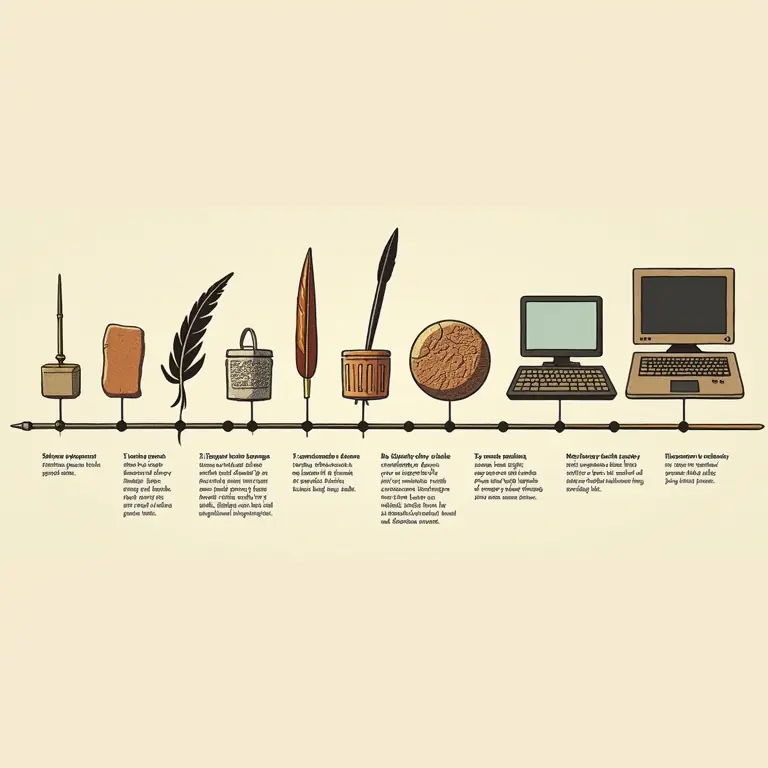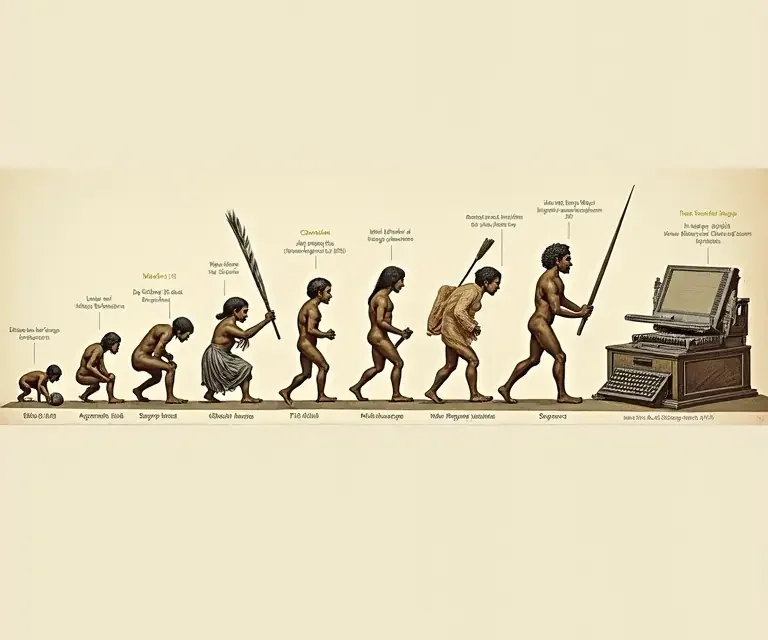Writing. It’s so ubiquitous in modern life that it’s easy to take for granted. We communicate through text messages, emails, social media posts, and countless other digital formats daily. But for millennia, recording and transmitting information wasn’t so simple. The story of writing technologies is a fascinating journey of human ingenuity, driven by the fundamental need to preserve knowledge, communicate across distances, and build upon the achievements of past generations. This article will trace that journey, from the earliest cave paintings to the digital word processors we use today, exploring the materials, methods, and cultural impacts of each innovation.
The Dawn of Writing: Before the Alphabet
Before alphabets, before even standardized symbols, there was a desire to record. The earliest forms of ‘writing’ weren’t writing as we understand it, but rather visual representations of ideas. Cave paintings, dating back as far as 40,000 years ago, found in places like Lascaux, France, and Altamira, Spain, depict animals, hunts, and abstract symbols. While their precise meaning remains debated, they clearly demonstrate a capacity for symbolic thought and communication. Were they purely artistic expressions? Records of successful hunts? Or perhaps early forms of storytelling and ritual?
The next major step came with the development of token systems in Mesopotamia around 8000 BCE. These weren’t writing in the conventional sense, but rather a way to represent quantities of goods. Clay tokens of various shapes and sizes were used to track livestock, grain, and other commodities. Over time, these tokens were flattened and markings were pressed into the clay, eventually leading to the development of pictograms – simplified pictures representing objects.
Cuneiform and Hieroglyphs: The Rise of Logographic Systems
Around 3200 BCE, the Sumerians in Mesopotamia developed cuneiform, considered the first true writing system. Cuneiform started as pictograms but evolved into a more abstract system using wedge-shaped marks impressed into clay tablets with a reed stylus. Importantly, cuneiform moved beyond simply representing objects to representing sounds and ideas, although it remained largely logographic – meaning each symbol represented a word or morpheme.
Almost simultaneously, in ancient Egypt, hieroglyphs emerged. Hieroglyphs were also logographic, using intricate pictures to represent words, sounds, and concepts. However, unlike cuneiform, hieroglyphs retained a strong pictorial quality and were often used for monumental inscriptions and religious texts. The complexity of hieroglyphs meant literacy was largely confined to scribes and the priestly class. Deciphering hieroglyphs remained a mystery for centuries until the discovery of the Rosetta Stone in 1799, which provided a parallel text in hieroglyphs, Demotic script, and Ancient Greek, unlocking the secrets of this ancient writing system. If you’re fascinated by hidden histories, you might enjoy exploring the hidden stories in street names – another example of deciphering the past.
The Alphabetic Revolution: From Phoenicia to Rome
A pivotal moment in the history of writing came with the development of the alphabet. The Phoenician alphabet, emerging around 1200 BCE, was a significant departure from logographic systems. It was alphabetic – meaning each symbol represented a single sound. This system was much simpler and more efficient than its predecessors, requiring fewer symbols to learn and use.
The Phoenician alphabet was adopted and adapted by the Greeks, who added vowels, creating a more complete and versatile system. The Greek alphabet, in turn, influenced the development of the Etruscan alphabet and ultimately the Roman alphabet, which forms the basis of the writing systems used by many languages today, including English. The Romans didn’t just adopt the alphabet; they also refined writing materials and techniques, favoring parchment and vellum (made from animal skins) over clay tablets and papyrus.

Writing Materials Through the Ages
The evolution of writing wasn’t just about the symbols themselves, but also about the materials used to record them. Here’s a brief overview:
- Clay Tablets: Used extensively in Mesopotamia for cuneiform. Durable but heavy and cumbersome.
- Papyrus: Made from the papyrus plant in Egypt. Lightweight and relatively easy to produce, but fragile and susceptible to damage.
- Parchment & Vellum: Made from animal skins. More durable than papyrus, but more expensive and time-consuming to produce. Vellum, made from calfskin, was of higher quality than parchment, made from sheep or goatskin.
- Wax Tablets: Commonly used in ancient Greece and Rome for notes and drafts. A stylus was used to scratch into the wax surface, which could be smoothed over and reused.
- Paper: Invented in China around 105 CE by Cai Lun. Initially made from plant fibers like hemp and rags, paper was significantly cheaper and easier to produce than parchment or vellum, revolutionizing writing and knowledge dissemination.
The Medieval Manuscript: A Labor of Love
During the Middle Ages, the production of manuscripts was largely confined to monasteries. Monks meticulously copied texts by hand, preserving classical knowledge and religious works. This was a slow, painstaking process, often taking months or even years to complete a single book. The artistry of medieval manuscripts went beyond simply copying text; illuminated manuscripts featured elaborate illustrations, decorative borders, and intricate calligraphy, making them works of art in their own right.
The development of the Carolingian minuscule script in the 8th century CE was a significant improvement in legibility and efficiency. This standardized script facilitated the wider distribution of texts and contributed to the cultural revival of the Carolingian era. The painstaking nature of manuscript production also led to occasional… shall we say… creative reinterpretations of texts. Sometimes, these weren’t innocent errors, but deliberate fabrications. You can explore similar instances of deception in the curious case of historical hoaxes.
The Printing Press: A Technological Leap
Johannes Gutenberg’s invention of the printing press with movable type in the mid-15th century was a watershed moment in the history of writing. For the first time, books could be produced quickly and in large quantities. This dramatically reduced the cost of books, making them accessible to a wider audience and fueling the Renaissance, the Reformation, and the Scientific Revolution. The printing press not only democratized knowledge but also standardized spelling and grammar, contributing to the development of modern languages.
Early printing presses used oil-based inks and paper made from linen or cotton rags. Over time, printing technology continued to evolve, with improvements in press design, ink composition, and paper manufacturing. The invention of the lithographic printing process in the late 18th century allowed for the reproduction of images and text with greater detail and efficiency.
The 19th and 20th Centuries: Typewriters, Computers, and Beyond
The 19th century saw the development of the typewriter, offering a mechanical means of producing clear, legible text. Early typewriters were cumbersome and expensive, but they gradually became more affordable and widespread, transforming the world of business and communication. The typewriter also had a significant impact on women’s employment, creating new opportunities for clerical work.

The 20th century brought about the most dramatic changes in writing technology with the advent of computers. Early computers were massive, expensive machines used primarily for scientific and military purposes. However, as technology advanced, computers became smaller, more affordable, and more accessible. The development of word processing software in the 1970s and 1980s revolutionized the writing process, allowing for easy editing, formatting, and storage of text.
The internet and the World Wide Web further transformed writing, enabling instant communication and the global sharing of information. Email, instant messaging, blogs, social media, and countless other digital platforms have created new forms of writing and new ways to connect with others.
The Digital Age: New Challenges and Opportunities
The digital age presents both challenges and opportunities for writing. The ease of digital communication has led to a decline in formal writing skills, with many people relying on abbreviations, slang, and emojis. The spread of misinformation and “fake news” poses a threat to the integrity of information. However, digital technology also offers unprecedented opportunities for creativity, collaboration, and access to knowledge.
Artificial intelligence (AI) is now playing an increasingly significant role in writing, with tools like grammar checkers, style guides, and even AI-powered content generators. While these tools can be helpful, they also raise ethical questions about authorship and originality. The ability to analyze vast datasets allows AI to identify patterns and even predict future trends – a principle mirrored in disciplines like mathematics. If you’re curious about hidden patterns, take a look at the geometry of everyday objects.
The Future of Writing
What does the future hold for writing technologies? It’s likely that we’ll see continued advancements in AI-powered writing tools, as well as new forms of immersive and interactive writing experiences. Virtual reality (VR) and augmented reality (AR) could create new ways to engage with stories and information. Brain-computer interfaces (BCIs) could even allow us to write directly with our thoughts. The possibilities are endless.
However, regardless of the technology used, the fundamental purpose of writing remains the same: to communicate, to preserve knowledge, and to connect with others. The journey from quill to keyboard has been a long and remarkable one, and it’s a story that continues to unfold.
The materials we use to write aren’t just functional; they often have fascinating geological origins. Exploring those origins can reveal surprising connections to the earth and its processes. For those interested in the hidden world beneath our feet, consider learning about the secret lives of common minerals.
And as we navigate this ever-evolving landscape of writing technologies, it’s worth remembering that the skills of clear thinking, effective communication, and critical analysis will always be essential. After all, technology is just a tool; it’s how we use it that truly matters.
The need for skilled communicators is more vital than ever. If you’re interested in a career focused on crafting clear and concise content, you might find exploring the work of technical writers insightful. Here’s a glimpse into their world:

